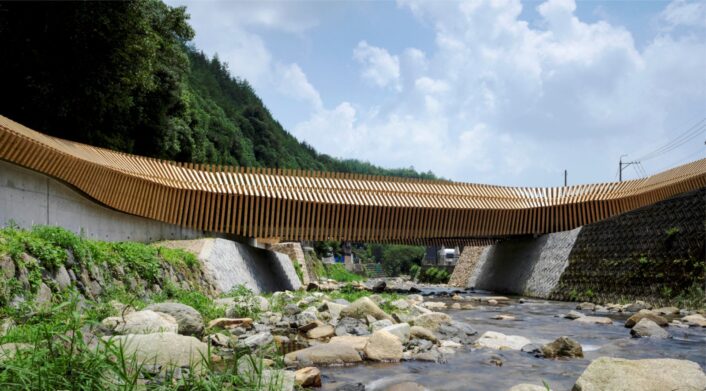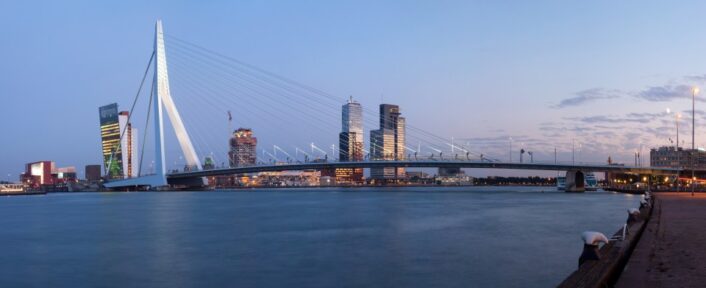Architecture
Arches in L.A.

The Sixth Street Viaduct earned the honor of being the largest bridge project in the history of Los Angeles.
Image courtesy of: Sustainable Infrastructure
The original Sixth Street Viaduct was built in 1932 and at two-thirds of a mile long, it was the last of the monumental river bridges in Classical Moderne design era. The graceful steel arches that flanked the bridge on both sides of the Los Angeles River stood in iconic fashion. In 1986, the landmark was deemed eligible in the National Register of Historic Places. Having been featured in countless movies, television shows, and commercials; it is one of the most recognized historic bridges in our country.
However in 2016, the bridge was closed for traffic and soon thereafter, prepared for immediate demolition. Due to an alkali-silica reaction, the bridge had slowly been eroding. Last year, the new Sixth Street Viaduct opened after a multi-year project that was the culmination of an international design competition lead by the City of Los Angeles Bureau of Engineering.

An aerial view of the Sixth Street Viaduct.
Image courtesy of: AIA Los Angeles
With such big shoes to fill, it makes sense that an international design competition ensued. The sheer magnitude of this infrastructure project emphasized Los Angeles’ commitment to ensuring that the viaduct gains “iconic status.” Architect Michael Maltzan and his design team, along with HNTB (engineering architect), Hargreaves Associates (landscape architects), and AC Martin (urban planning conglomerate) began the project with the philosophy that the viaduct is more than just a bridge to get someone from Point A to Point B. Rather, the proposal looked into the future to a multi-modal Los Angeles that both accommodates cars and incorporates pivotal bicycle access points. In addition, increasing accessibility for pedestrians throughout the entirety of the bridge was paramount in the design.
By linking the bridge, the Los Angeles River, and the urban landscape together in a reverent way, the viaduct became more than an infrastructure feature. When the viaduct opened last July, Los Angeles gained an impressive and imposing landmark.

The viaduct is the longest of the fourteen bridges that connect the east and west towns across the Los Angeles River. The new viaduct is 100-feet-across whereas the previous iteration was 46-feet-across.
Image courtesy of: Dezeen
The new viaduct connects the city’s downtown and Arts District areas with the Boyle Heights neighborhood. The design called for ten concrete arches of varying heights which loop up and down on either side of the bridge for two-thirds of a mile. Each individual segment is cast-in-place with a configuration of tension cables that swoop down under the road’s surface and converge upon the arch to form a Y-shaped arrangement that rests on the base.
The arches on either side mirror one another’s height. Courtesy of Architectural Record, “In homage to the 1932 design, the tallest arcs (which rise 60 feet and span rail tracks) are modified twin peaks- reinterpreting and integrating the original gesture with greater continuity’s the curving, up-and-down rhythms are no longer confirmed to one section.” The flexible design, mainly influenced by varying heights, weaves gracefully between the numerous high-voltage power-lines in the vicinity.

A rendering…
Image courtesy of: 64 North
Construction ensued in 2016 and final cost was $588 million… the project was funded by the Federal Highway Transportation Administration, the California Department of Transportation, and the City of Los Angeles. The biggest concern was that the bridge and forthcoming projects would change Boyle Height’s core authenticity. The city however vowed to maintain the neighborhood’s affordability and character… this was alleviated by creating public access and new amenities.
Five stairways, in addition to an ADA-compatible and bicycle-friendly helical ramp, link the raised roadway with the new parkway underneath and around it. Designed by the Kansas City-based Hargreaves Jones, the 12-acre public park provides recreational fields, restrooms, a cafe, public art, and a programmed arts plaza.

The original Sixth Street Viaduct.
Image courtesy of: KCET
The new viaduct has been nicknamed the “Ribbon of Light” because of its dramatic nighttime illuminations of the roadbed. LEDs are embedded low in the concrete barriers and up-lights cast luminosity upon the arches. Maltzan spoke of “the why” in regards to his design (courtesy of Arch Paper), “The responsibility of infrastructure is to try to anticipate and provide for a contemporary city—a city continuing to evolve. One absolute constant in the equation is that the city in ten years will be different city than it is today.” We couldn’t agree more!


